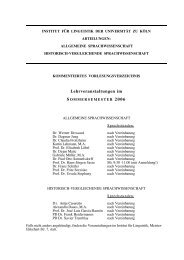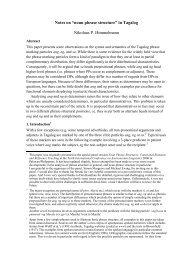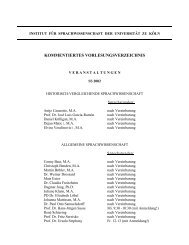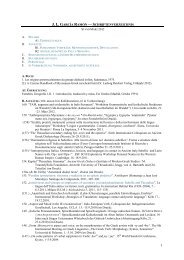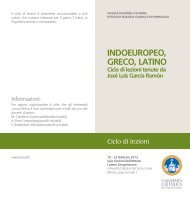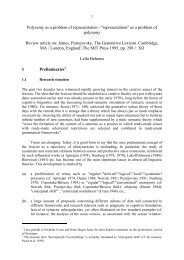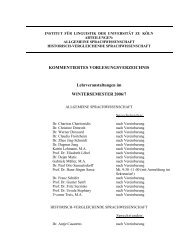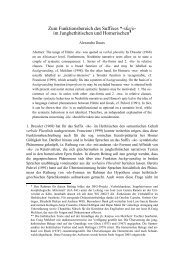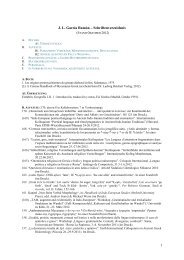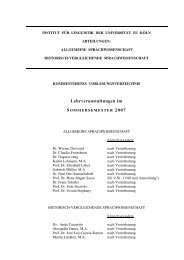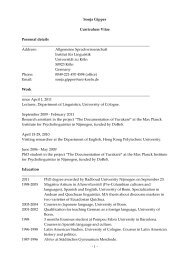Topics in Anatolian Historical Grammar Prof. Dr. H. Craig Melchert
Topics in Anatolian Historical Grammar Prof. Dr. H. Craig Melchert
Topics in Anatolian Historical Grammar Prof. Dr. H. Craig Melchert
You also want an ePaper? Increase the reach of your titles
YUMPU automatically turns print PDFs into web optimized ePapers that Google loves.
10<br />
contrast<strong>in</strong>g example to prove that the first two changes did not apply also to<br />
velars are lack<strong>in</strong>g! Although the determ<strong>in</strong>ative obviously is quite suggestive, we<br />
cannot be sure that HLuvian (CORNU)ki-pu-tà/ra- (/kibud(a)-/ or /kipud(a)-/)<br />
refers to the crescent horn of the moon (see Hawk<strong>in</strong>s 2000: 470 on the problem<br />
and Puhvel 1997: 188 on the questionable Hittite-context SI kiputi-). Even if it<br />
does, the derivation suggested above from a root mean<strong>in</strong>g ‘bent, curved’ is a<br />
mere possibility and is not the sort of etymology on which one bases a sound<br />
law.<br />
At least suggestive is the apparent contrast we f<strong>in</strong>d between palatalization of<br />
*k <strong>in</strong> HLuvian zurnid- ‘horn’ < *kr̥ng-id- and the lack thereof <strong>in</strong> CLuvian gurta-<br />
‘citadel’ < *ghr̥dho-. I must <strong>in</strong>sist on the latter etymology, aga<strong>in</strong>st that from<br />
*g w (H)to- (e.g. Bader 1991: 127, Kimball 1999: 250). The problem is not<br />
formal (aga<strong>in</strong>st <strong>Melchert</strong> 1994: 260), s<strong>in</strong>ce the labiovelar could have been<br />
unrounded by the round anaptyctic vowel before be<strong>in</strong>g deoccluded: *g w (H)to- ><br />
*g w orto- > gurta- (read /gorta-/). 13 The <strong>in</strong>surmountable obstacle is the<br />
semantics: all reflexes of the root *g w erH- <strong>in</strong> question mean ‘mounta<strong>in</strong>’<br />
(Sanskrit giri-, Avestan gairi-, OCS gora) or refer to natural phenomena<br />
putatively associated with mounta<strong>in</strong>s, such as Greek βορέᾱς ‘north w<strong>in</strong>d’ <<br />
‘w<strong>in</strong>d off the mounta<strong>in</strong>s’. However, it is clear from the use of CLuvian gurta- <strong>in</strong><br />
the Deeds of Suppiluliuma that the word refers to a man-made fortified<br />
enclosure, which is not necessarily on a high place: KBo 5.6 iii 33: šarāzzi gurti<br />
‘<strong>in</strong>to the upper citadel/walled city’. If gurta- meant <strong>in</strong>herently ‘acropolis, high<br />
place’, it would be po<strong>in</strong>tless to specify it as ‘upper’, which clearly implies the<br />
existence of a similar lower enclosure. The problem for our present <strong>in</strong>quiry is<br />
that the absence of palatalization <strong>in</strong> gurta- < *ghr̥dho- cannot prove that a<br />
sequence of voiced front velar *g(h) plus syllabic * did palatalize. It is only<br />
such a direct contrast with<strong>in</strong> the voiced series that would be probative, because<br />
even if there was conditioned palatalization of only front velar *g(h) and not<br />
non-front velar *g(h), we cannot simply assume that the condition<strong>in</strong>g matched<br />
precisely that of the voiceless series (especially <strong>in</strong> non-obvious environments<br />
such as *).<br />
As already noted above, the general treatment of medial voiced front velars<br />
and non-front velars is obscured by uncerta<strong>in</strong>ty about the precise conditions on<br />
the deletion or retention of both. Medial loss before vowel seems likely. See<br />
<strong>Melchert</strong> 2004b: 377 for HLuvian pa- ‘allocate; receive a portion’ < *bhag-V-.<br />
In the word for ‘daughter’ the unsyllabifiable *dhugh 2 tr- received an anaptyctic<br />
vowel colored by the laryngeal, which was then lost regularly before stop. Loss<br />
of the prevocalic *g and then glide <strong>in</strong>sertion led regularly to HLuvian<br />
13 This rema<strong>in</strong>s true whether one derives Hittite gulšš- and Luvian gulz- ‘<strong>in</strong>scribe’ from *g w s-<br />
‘prick’ (thus with Puhvel 1997: 244 follow<strong>in</strong>g Carruba) or from *k w s- (Oett<strong>in</strong>ger 1979: 204 et<br />
al.). As Puhvel rightly <strong>in</strong>sists, that choice must be made on other grounds.



